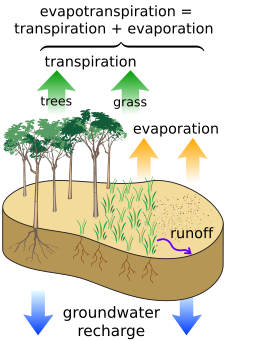

Evapotranspiration (ET) refers to the combined processes which move water from the Earth's surface (open water and ice surfaces, bare soil and vegetation) into the atmosphere.[2]: 2908 It covers both water evaporation (movement of water to the air directly from soil, canopies, and water bodies) and transpiration (evaporation that occurs through the stomata, or openings, in plant leaves). Evapotranspiration is an important part of the local water cycle and climate, and measurement of it plays a key role in water resource management agricultural irrigation.[3]
- ^ Brun, P., Zimmermann, N.E., Hari, C., Pellissier, L., Karger, D.N. (preprint): Global climate-related predictors at kilometre resolution for the past and future. Earth Syst. Sci. Data Discuss. https://doi.org/10.5194/essd-2022-212 Archived 2023-01-08 at the Wayback Machine
- ^ IPCC, 2022: Annex II: Glossary [Möller, V., R. van Diemen, J.B.R. Matthews, C. Méndez, S. Semenov, J.S. Fuglestvedt, A. Reisinger (eds.)]. In: Climate Change 2022: Impacts, Adaptation and Vulnerability. Contribution of Working Group II to the Sixth Assessment Report of the Intergovernmental Panel on Climate Change [H.-O. Pörtner, D.C. Roberts, M. Tignor, E.S. Poloczanska, K. Mintenbeck, A. Alegría, M. Craig, S. Langsdorf, S. Löschke, V. Möller, A. Okem, B. Rama (eds.)]. Cambridge University Press, Cambridge, UK and New York, NY, USA, pp. 2897–2930, doi:10.1017/9781009325844.029.
- ^ "Evapotranspiration - an overview | ScienceDirect Topics". www.sciencedirect.com. Retrieved 2022-05-02.